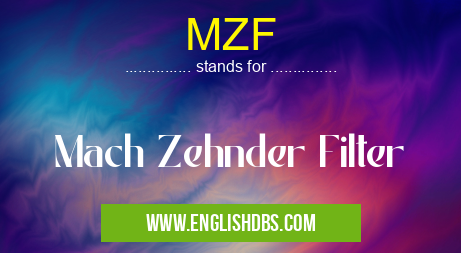What does MZF mean in UNCLASSIFIED
MZF (Mach Zehnder Filter) is an optical filter used in telecommunications to separate optical signals based on their wavelength. It is a type of interference filter that utilizes the principle of interference to achieve selective wavelength transmission.

MZF meaning in Unclassified in Miscellaneous
MZF mostly used in an acronym Unclassified in Category Miscellaneous that means Mach Zehnder Filter
Shorthand: MZF,
Full Form: Mach Zehnder Filter
For more information of "Mach Zehnder Filter", see the section below.
How Does an MZF Work?
An MZF consists of two arms, each containing a beam splitter and a mirror. Light entering the MZF is split into two beams by the first beam splitter. These beams travel through the arms and are reflected by the mirrors back to the second beam splitter. The second beam splitter combines the beams, resulting in constructive or destructive interference depending on the wavelength of the light.
Constructive and Destructive Interference
- Constructive Interference: When the optical path length difference between the two arms is an integer multiple of the wavelength, the beams interfere constructively, resulting in a high transmission of light at that particular wavelength.
- Destructive Interference: When the optical path length difference is a half-integer multiple of the wavelength, the beams interfere destructively, resulting in low transmission of light at that wavelength.
Applications of MZF
MZFs are widely used in various applications, including:
- Wavelength Division Multiplexing (WDM): Separating and combining multiple optical signals with different wavelengths in fiber-optic communication systems.
- Optical Switching: Switching optical signals between different paths based on their wavelength.
- Optical Filtering: Filtering out unwanted wavelengths from optical signals, such as noise or crosstalk.
- Spectroscopy: Analyzing the wavelength distribution of light sources.
Essential Questions and Answers on Mach Zehnder Filter in "MISCELLANEOUS»UNFILED"
What is a Mach Zehnder Filter (MZF)?
A Mach Zehnder Filter (MZF) is a type of optical filter that uses the principle of interference to selectively filter out specific wavelengths of light. It consists of two parallel waveguides that are coupled together via a directional coupler. The waveguides are typically made of glass or semiconductor materials.
How does an MZF work?
Light entering the MZF is split into two paths by the directional coupler. These paths travel through the waveguides and are then recombined at the output. The phase difference between the two paths determines the wavelengths of light that are transmitted or reflected. By carefully designing the length and refractive index of the waveguides, it is possible to create an MZF that filters out specific wavelengths of light.
What are the applications of MZFs?
MZFs are used in a variety of applications, including:
- Optical communications
- Spectroscopy
- Laser wavelength stabilization
- Sensing
What are the advantages of MZFs?
MZFs offer several advantages over other types of filters, including:
- High spectral resolution
- Compact size
- Low insertion loss
- Polarization independence
What are the disadvantages of MZFs?
MZFs also have some disadvantages, including:
- They can be sensitive to temperature and environmental conditions.
- They can be difficult to manufacture.
- They can be expensive.
Final Words: MZFs are versatile and efficient optical filters that play a crucial role in telecommunications and spectroscopy. They enable the manipulation and separation of optical signals based on their wavelength, facilitating advanced applications such as WDM and optical switching.
